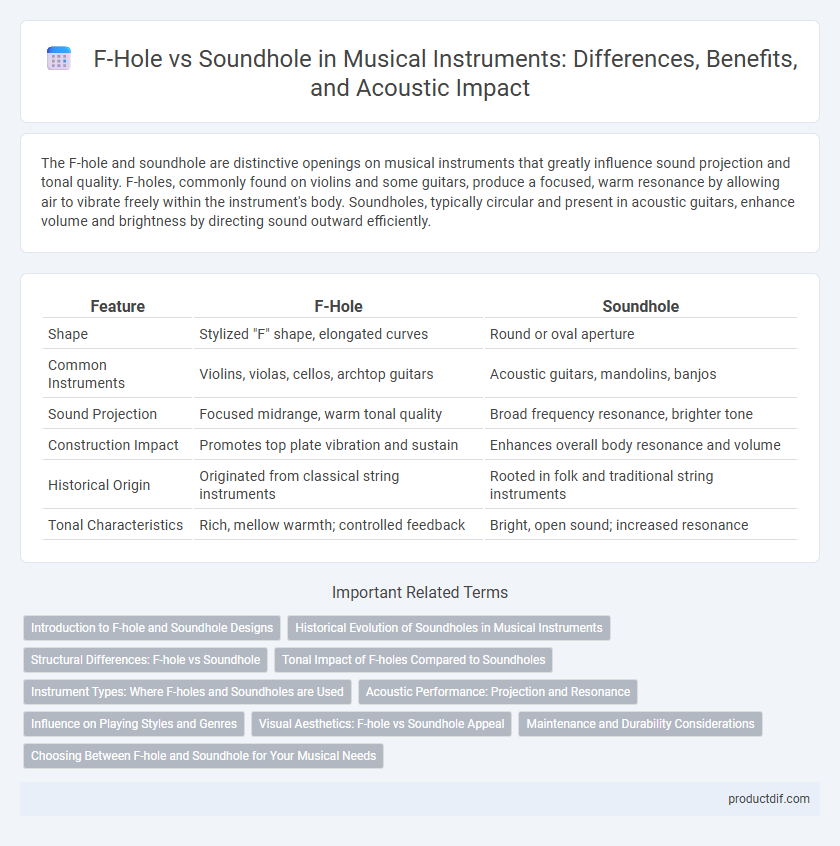The F-hole and soundhole are distinctive openings on musical instruments that greatly influence sound projection and tonal quality. F-holes, commonly found on violins and some guitars, produce a focused, warm resonance by allowing air to vibrate freely within the instrument's body. Soundholes, typically circular and present in acoustic guitars, enhance volume and brightness by directing sound outward efficiently.
Table of Comparison
| Feature | F-Hole | Soundhole |
|---|---|---|
| Shape | Stylized "F" shape, elongated curves | Round or oval aperture |
| Common Instruments | Violins, violas, cellos, archtop guitars | Acoustic guitars, mandolins, banjos |
| Sound Projection | Focused midrange, warm tonal quality | Broad frequency resonance, brighter tone |
| Construction Impact | Promotes top plate vibration and sustain | Enhances overall body resonance and volume |
| Historical Origin | Originated from classical string instruments | Rooted in folk and traditional string instruments |
| Tonal Characteristics | Rich, mellow warmth; controlled feedback | Bright, open sound; increased resonance |
Introduction to F-hole and Soundhole Designs
F-holes and soundholes are pivotal in defining the acoustic character of stringed instruments, impacting sound projection and tonal quality. F-holes, commonly found on violins, violas, and archtop guitars, feature slender, curved openings that enhance mid to high-frequency resonance and contribute to a focused sound. Soundholes, typically circular and seen on classical and acoustic guitars, support broader sound dispersion and balanced tonal output across frequencies.
Historical Evolution of Soundholes in Musical Instruments
F-holes evolved from ancient round soundholes, gradually becoming a defining feature in violin family instruments during the 16th century. The transition from simple round holes to ornate f-shaped designs enhanced sound projection and tonal clarity, reflecting advancements in lutherie and acoustic understanding. This historical evolution highlights a shift from functional openings to aesthetically and acoustically optimized soundholes tailored for specific instrument types.
Structural Differences: F-hole vs Soundhole
F-holes are elongated, stylized openings typically found on violins, cellos, and archtop guitars, designed to enhance the instrument's resonance and projection by allowing air to move efficiently within the hollow body. Soundholes, commonly circular and located on flat-top guitars, serve a similar acoustic purpose but differ structurally by providing a larger, more centralized aperture that influences tonal qualities and volume distribution. The distinct shapes and placements of F-holes versus soundholes significantly impact the way vibrations travel through the instrument's body, affecting sound timbre and projection unique to each design.
Tonal Impact of F-holes Compared to Soundholes
F-holes, commonly found on violins and archtop guitars, enhance tonal clarity and focus by allowing air to vibrate within the instrument's body differently than round soundholes. This design emphasizes midrange frequencies and produces a more projecting, articulate sound ideal for genres like jazz and classical music. In contrast, round soundholes on flat-top guitars generate a broader frequency response with deeper bass resonance, creating a warmer, more balanced tone suited for folk and contemporary styles.
Instrument Types: Where F-holes and Soundholes are Used
F-holes are predominantly found on arched-top string instruments such as violins, violas, cellos, and archtop guitars, enhancing the instrument's resonance by directing sound through their narrow, f-shaped openings. Soundholes, typically round or oval, are standard on flat-top acoustic guitars, mandolins, and other folk instruments, facilitating air movement to amplify volume and tone. The choice between F-holes and soundholes directly influences an instrument's acoustic properties and is closely tied to its construction style and musical genre application.
Acoustic Performance: Projection and Resonance
F-holes, commonly found on violins and archtop guitars, enhance acoustic performance by directing sound waves efficiently, resulting in focused projection and rich resonance. Soundholes, typical in flat-top acoustic guitars, facilitate broader sound dispersion, creating a warmer and more balanced tonal response. The choice between F-hole and soundhole design significantly influences an instrument's tonal character and volume projection.
Influence on Playing Styles and Genres
F-holes, commonly found on violins, cellos, and archtop guitars, enhance tonal projection and sustain, making them ideal for jazz, blues, and classical music that emphasize nuanced articulation and dynamic control. Soundholes, typical in acoustic guitars and other folk instruments, produce a brighter, more resonant sound suited for strumming and rhythmic playing styles seen in folk, country, and pop genres. The choice between F-hole and soundhole directly influences the instrument's voice, shaping the player's approach and suitability for specific musical expressions.
Visual Aesthetics: F-hole vs Soundhole Appeal
F-holes, commonly found on violins, cellos, and archtop guitars, offer a sleek, elegant visual appeal with their curved, stylized shapes that complement the instrument's classic design. Soundholes, often round and centered on acoustic guitars, provide a traditional and straightforward aesthetic that emphasizes symmetry and simplicity. The choice between F-hole and soundhole designs significantly influences the instrument's visual identity, aligning with specific styles and player preferences.
Maintenance and Durability Considerations
F-holes, commonly found on violins and archtop guitars, require regular cleaning to prevent dust accumulation inside the instrument's body, which can affect sound quality and resonance. Soundholes, typical in acoustic guitars, are more exposed and easier to inspect but can also collect debris and moisture, necessitating consistent humidity control to avoid wood warping or cracking. Both designs demand careful maintenance of the instrument's body and internal components to ensure long-term durability and optimal tonal performance.
Choosing Between F-hole and Soundhole for Your Musical Needs
F-holes, commonly found on violins and archtop guitars, offer focused sound projection with enhanced midrange tones, ideal for jazz and blues styles. Soundholes, typically circular and central on acoustic guitars, provide a balanced resonance and robust volume suitable for diverse genres like folk and rock. Selecting between F-hole and soundhole depends on desired tonal characteristics, projection needs, and the specific musical genre you intend to play.
F-hole vs Soundhole Infographic

 productdif.com
productdif.com